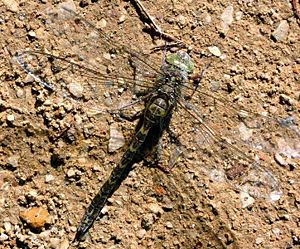Western spirit dragonfly
| Western spirit dragonfly | ||||||||||||
|---|---|---|---|---|---|---|---|---|---|---|---|---|

Western spirit dragonfly ( Boyeria irene ) |
||||||||||||
| Systematics | ||||||||||||
|
||||||||||||
| Scientific name | ||||||||||||
| Boyeria irene | ||||||||||||
| ( Fonscolombe , 1838) |
The western spirit dragonfly ( Boyeria irene ) is a species of dragonfly from the family of the noble dragonflies (Aeshnidae), which belong to the suborder of the large dragonflies (Anisoptera).
features
The western spirit dragonfly reaches wingspans of 8.5 to 9.5 centimeters. The females of this species are colored brown, the males have a cloudy green markings on the chest section ( thorax ) and on the abdomen ( abdomen ). It can only be confused with the species Boyeria cretensis ( Cretan ghost dragonfly ), which was first described from Crete in 1991 and which, in addition to its distribution on this island, also has sharper markings.
distribution
The western spirit dragonfly lives in the western Mediterranean area ( Portugal , Spain , southern and central France , Italy , North Africa ), with the range in the north extending to some regions of Switzerland (e.g. Lake Lucerne ) and Lake Constance . In 2008 it was detected for the first time in Lower Saxony.
Way of life
The animals fly from July to September and can be found almost exclusively on streams and rivers in the south, while the species develops in lakes in Switzerland. The hunting season is dusk and you can find them on their hunting flights far away from the water. The bright street areas in particular attract the animals, which is why they are very often victims of vehicles rushing by.
The males fly along the banks of the rivers to mate in search of the females or they cross over the water surface. The mating begins and ends above the water in the vegetation. The females lay their eggs by piercing tree roots on the bank.
Larval development
The larvae prefer to live in the scree of permanent flowing water, hidden between loosely packed pebbles. The duration of their development is two, sometimes three years. The emergence occurs in June and July on vertical structures directly at the edge of the water, preferably on vertical or overhanging rocks.
Individual evidence
- ^ Hans-Joachim Clausnitzer, Rüdiger Hengst, Carsten Krieger, Andrea Thomes (2010): Boyeria irene in Lower Saxony (Odonoata: Aeshnidae). Libellula 29 (3/4): 155-168
literature
- Bellmann H (1993): Observing dragonflies - determining , Naturbuch Verlag Augsburg, ISBN 3894401079
- Jurzitza G (2000): Der Kosmos-Libellenführer , Franckh-Kosmos Verlags GmbH & Co., Stuttgart, ISBN 3440084027
- Peters G (1987): The noble dragonflies of Europe - Aeshnidae , Die Neue Brehm-Bücherei Vol. 585, Ziemsen, Wittenberg, ISBN 3740300507
- Wildermuth H (2005): Contribution to the larval biology of Boyeria irene (Odonata: Aeshnidae). Libellula 24: 1-30